David Scaletti, March 2008
Read Time: 20 minutesFeature Interview with David Scaletti
March, 2008
Born on February 24, 1957, David graduated from RMIT in Australia with a Bachelor in Arts (Photography) in 1988 and has been a freelance professional photographer ever since. The first nine or ten years were spent in the field of commercial and advertising photography carrying out assignments for direct clients, various advertising agents, and graphic designers. Clients included Tourism Victoria, Department of Immigration, Telstra, Pasminco Mining, National Australia Bank, and the Victorian Arts Centre. His interest in golf course photography began as a result of his inability to find a quality calendar of local golf courses. So, instead, David published one himself! He went on to become the licsensee for producing a calendar and limited edition print of The Royal Melbourne Golf Club for the 1998 Presidents Cup. His photographs have appeared in numerous publications including The Sandbelt – Melbourne’s Golfing Heaven, the club history book for The National Golf Club, Australia’s Finest Golf Courses published in 2003, Golf…It’s a Funny Game in 2004, and most recently Planet Golf. The Definitive Reference to Great Golf Courses outside the United States of America in 2007. For more information, please visit his web site www.sportscapes.com.au.
How many countries did you travel to for Planet Golf?
Planet Golf has images from about 22 countries. Up until about a week ago I had never considered how many countries I went to, but the same question was asked a few days ago and caused me to count them up. While the actual number of countries had not been present in my mind, I was always aware of the number of days I spent away from home during the shooting of Planet Golf, 370 over a two year period. Given that this included travelling time I suppose each course had an average of about two and a half days to shoot. Sometimes I got lucky with the weather, other times I just had to make do with what conditions there were.
What are some favorite places you have been?
I have been very fortunate in the places I visited in the course of photographing Planet Golf, and I am pleased that you ask my favorite places in addition to my favorite courses. My approach to golf is a little holistic, perhaps a slight sin on this site of rabid golf architecture aficionados, but I like to be able to remember a destination and the course for the experience, as well as the golf.
Favorite places?…. In no particular order, Bonifacio, Dornoch, Cabo del Sol, Bermuda, Banff and Kawana/Asia in general.
By all means go to Corsica to play Sperone Golf Club, but for me the attraction is the nearby town of Bonifacio. If you like your real estate perched a few hundred feet vertically above the Mediterranean, atop limestone cliffs, then Bonifacio is the place for you. The town dates back to the 8th or 9th century and is one of the most beautiful towns I have had the pleasure to visit. Even if the golf doesn’t stir the juices you will enjoy Bonifacio.
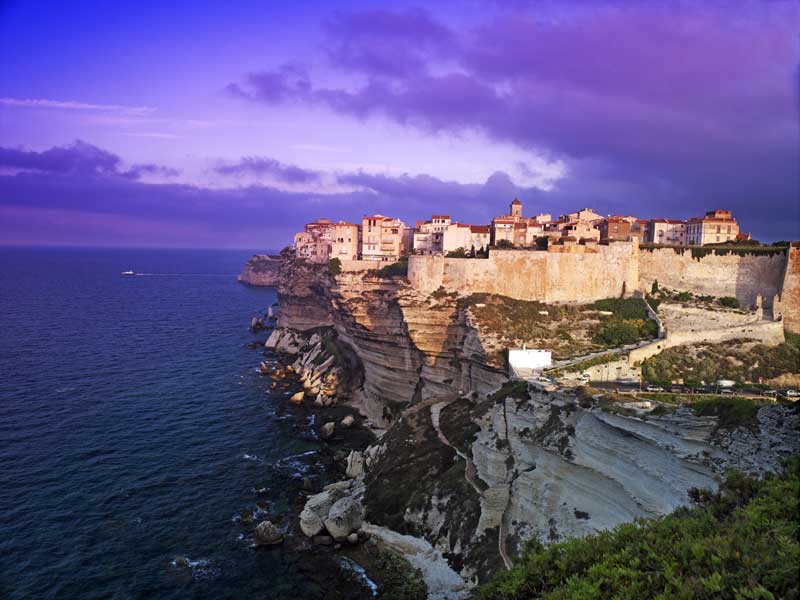
Dornoch. I know no-one will quibble with the quality of golf at this northern Scotland outpost. For me it is the ambience of the town, and most of all, the experience of staying at the Burghfield House Hotel. I have noted some references at various times on GolfClubAtlas to this fine establishment, and I can only concur that a stay there is great fun. When I first arrived in Dornoch I simply could not find a room in a Bed and Breakfast, and finally stumbled across the Burghfield. Despite the imposing façade it turned out to be very reasonable cost wise. This will seem sacrilegious to many, but I missed out on availing myself of some golf at Royal Dornoch. While there I was given courtesy of the course and could play when I wanted to. Being there in June, the longest days of the year, meant there was not much time between sunset and sunrise, and I was not getting much sleep. On the second or third afternoon I was contemplating playing again, as I reclined in the chesterfield in the lounge at the Burghfield. When I finally woke up I realized how tired I was. I wanted to go out and play, but I just couldn’t do it.
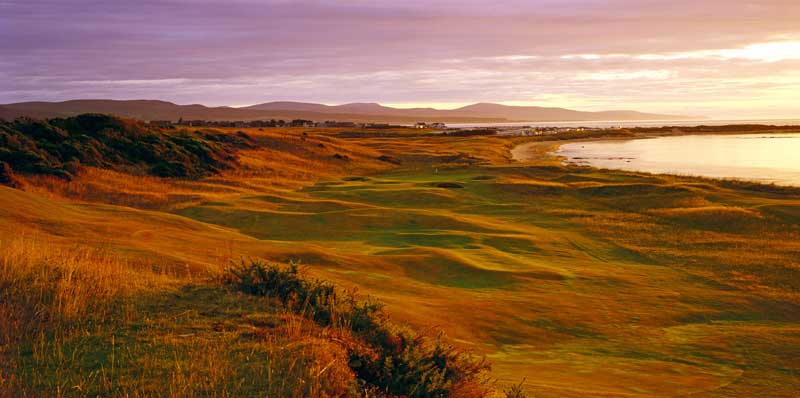
The eighth at Royal Dornoch as it sweeps downhill.
Cabo del Sol was a wonderful treat. I really enjoyed the course, although I think perhaps it could be too difficult for some. One guy in my group was very much a beginner golfer, but seemed determined to play regardless. His friend was a reasonable golfer, and before too long the first guy would simply play his ball from where his partner put his tee shot. There are many long carries and they were simply too much for the beginner. His problems were summarized later in the game when he found himself in a bunker that he simply could not get out of. It took him three attempts to throw the ball out!
At the first tee the starter announced that as it was getting a bit warmer he had to warn us about jumping cactuses (whatever they were) and rattlesnakes! “Any good news?” I asked him. Yes, we get complimentary burritos at the halfway house he informed me. I assumed that would be in the event that we survived that long.
If planning a trip that has to entertain a non-golfer as well as the golf nut, then Cabo has to be high on the list of possibilities. The setting is spectacular, the golf is fun, and the variety of activities is numerous. Plus, the facilities are such that all budgets are accommodated. As well, it is easy to get away from resort enclaves and see some of the local color. A great destination.
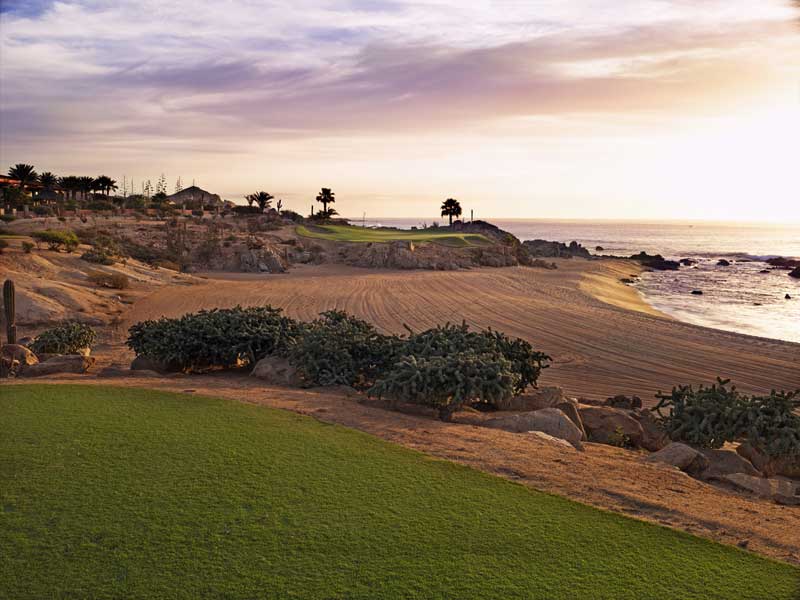
For the ultimate golfing experience I would have to settle on The Mid Ocean Club in Bermuda. If possible stay in the accommodation at the club and immerse yourself in the ambience that is Mid Ocean. There is a wonderful mix of British gentility and American “can do.” I’m not sure if that makes sense, but if you experience what Mid Ocean is about I think you will understand. The golf course seems to meander through the houses, but somehow doesn’t seem to have the claustrophobic feeling that some golf course/real estate developments have. I wondered as I set off for a game what the rules were in regard to out of bounds. What do I do if my ball lands on Mrs Trentham-Smyth’s kitchen table? I checked the local rules. “Out of Bounds: There is no out of bounds” Luckily I managed to avoid ruining anyone’s breakfast.
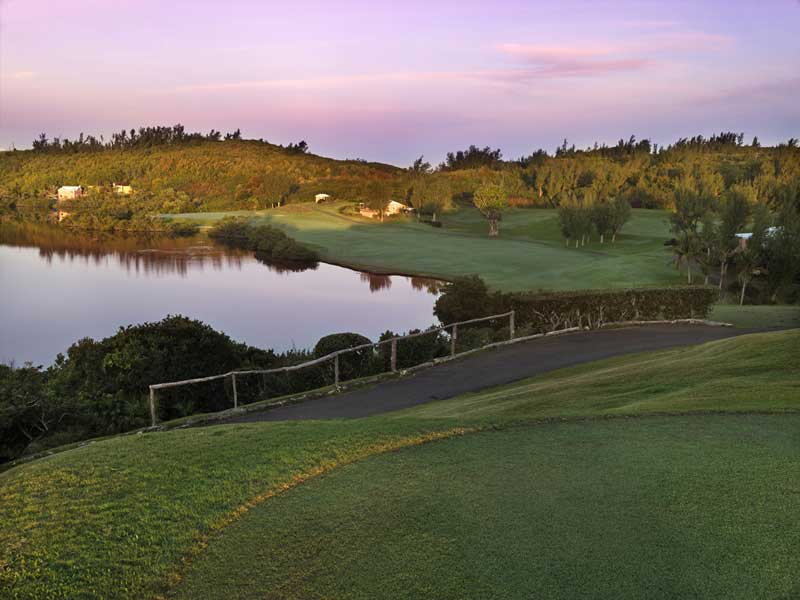
More years ago than I care to recall I spent a number of years living the life of a ski-bum. A couple of winters were spent in Banff, and it was a great joy to return to that beautiful place again. All those years ago I remember going down to the golf course and watching some people tee off from the old 1st tee, but golf at that time was just a passing interest and despite all the time I lived in Banff I never played golf. Fortunately that has been rectified, and I still think of Banff as one of the truly beautiful and spectacular parts of the world. Now I think of it as a golfing destination, as well as a place to go skiing. But more than golf and skiing, you should just go there to see nature at it’s most glorious. I don’t think I lie in saying it is my favourite destination in the world
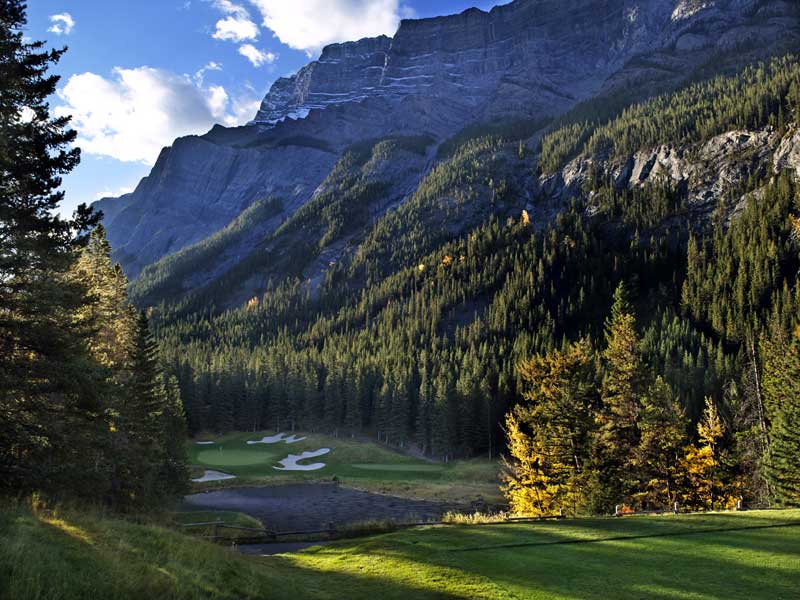
Stanley Thompson’s work captures the incomparable magic of the Canadian Rockies.
One of the real pleasures of my journeys was going to Asia. In truth I had been apprehensive as to how I was going to cope with the language barriers, different cultures and even the food. Very luckily I met Masa Nishijima here in Australia at a media day at St Andrews Beach. Masa was out here in company with Tom Doak and we met as I was about to head home after the day. We had a brief conversation, I think I gave him a copy of my book “Golf. It’s a funny game” and Masa gave me his card and the invitation to contact him if I was in Japan. When it came to planning Asia, Darius asked if I had any contacts and I suggested Masa. As they say, the rest is history, and Masa spared no effort in arranging both mine, and Darius’ itineraries. It was symbolic of everywhere I went in Asia, Japan, China and South Korea. I was treated as a long lost relative, and everywhere locals looked after me. When I arrived at Fukuoka train station en route to Koga Golf Club I had precise instructions on how to catch the connecting train. Trouble was I couldn’t read the signs. What a complete relief, and surprise, to see a total stranger standing in the middle of the walkway holding a copy of “Golf It’s funny game” high above his head. I now think of Mr Ohnishi as my Japanese saviour. My fears about language, cultural differences and the food were unfounded. And the food! At times very different, but absolutely magnificent. Favorite place in Asia, probably Kawana, but I thoroughly enjoyed everywhere I went.
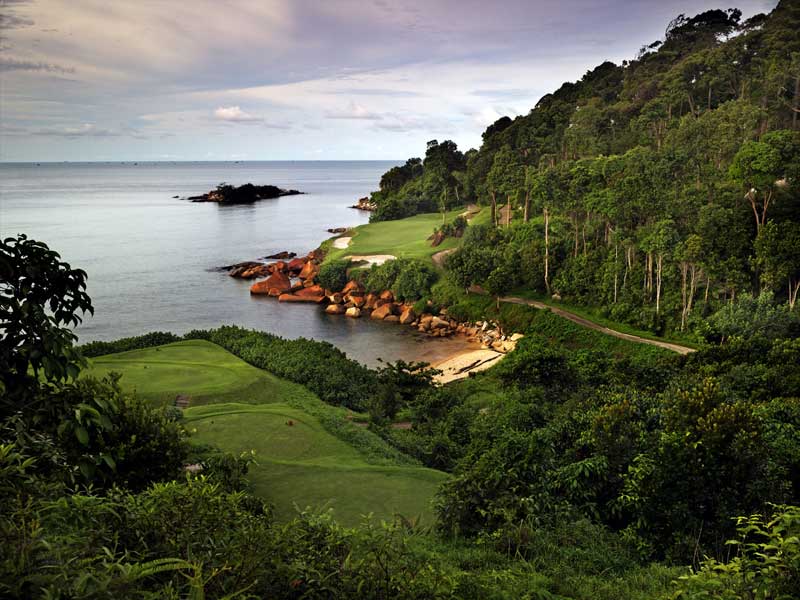
What course most surprisedyouduring your travels?
Many courses were a surprise to me, but that is a reflection on my lack of knowledge about so many of the great golfing arenas. I was often pleasantly surprised by the landscapes that were laid out in front of me to photograph. However there were four or five that particularly come to mind as being surprising. Funnily enough three of those have the same religious theme, St George. St George’s Hill in London, Royal St George’s in south England, and St George’s in Toronto.
I had watched Greg Norman win The Open at Royal St George’s, but the television coverage in no way prepared me for the grandeur of that course. In my minds eye I could see a relatively flat, demanding and tough golf course. How wrong could my impressions have been! Royal St George’s is as majestic a golf course as you could hope to play. Playing there is an exercise in enjoyment and discovery. The grandeur surrounds the golfer, but doesn’t intimidate. It is pure delight. I suppose my feelings could be explained by the fact that I had, for me, a very good score, but it was particularly sobering to realize that the tees I played from were 1000 yards shorter than the course the professionals play.
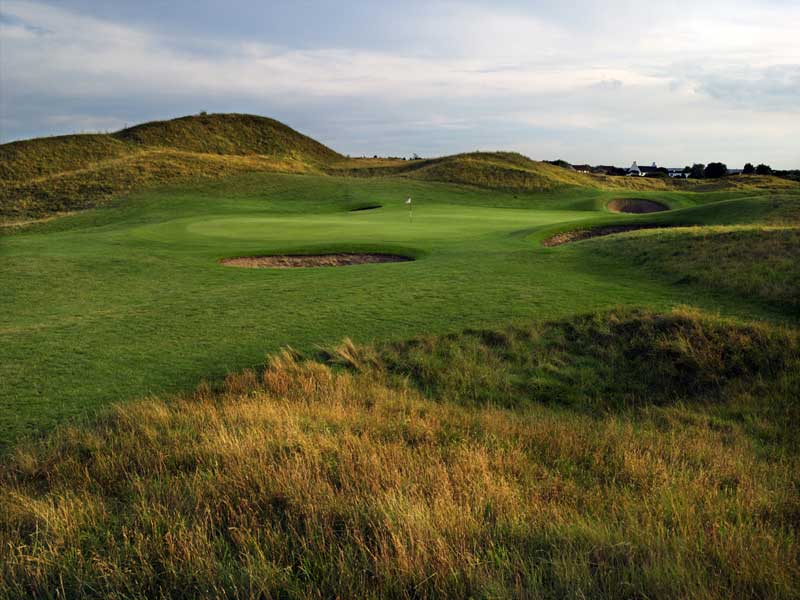
The two other St George’s share the delights of wonderfully rolling terrain and are simply a treat to play. Well, I assume that is the case. My greatest regret is that a game at St George’s didn’t eventuate, due to an unfortunate mix-up, but hopefully next time I’m in Toronto it will happen. I did experience the pleasures of a game at St George’s Hill and have to say to anyone who has the chance, don’t miss out should the opportunity arise.
Outside the St George’s the surprises were Royal Lytham and St Anne’s and St Enedoc. Actually having just written those names I see the religious theme continues. Again, I had watched The Open at Royal Lytham and having seen what appeared to be a flat, dry and seemingly dull course I was very apprehensive at the thought of photographing it. Shocking weather didn’t help, but I found that pre-conceived ideas were not accurate and Royal Lytham was indeed much more photogenic than I had expected. Golfing wise it seems to be a brutally tough test of your game. Be straight, or suffer the consequences.
What a gem resides in Cornwell. St Enodoc is a little out on its own, geographically speaking, in relation to other name golf courses, but the journey down there is well worth the effort. The terrain is dramatic, the scenery is gorgeous, and there is a warm sense of community in the clubhouse. Fun and enjoyment is the overriding impression of golf at St Enodoc. The journey around the course is as much a pleasant walk as a golfing challenge. You can’t help but feel invigorated and satisfied by the stroll, and it is even better if you can successfully negotiate such golfing gems as the 3rd, 4th, and 6th, to mention but a few. Whilst avoiding Himalaya bunker on 6 is the desired outcome, one can’t help but wonder whether you could extract yourself should you become entangled in its clutches.
In retrospect if I had to choose the most surprising I would have to choose St Enodoc. It has the ability to surprise, mystify and beguile the golfer. St Enodoc’s charms will easily have people returning time and again with the simple intention of trying to unravel the mysteries of an intriguing golf course.
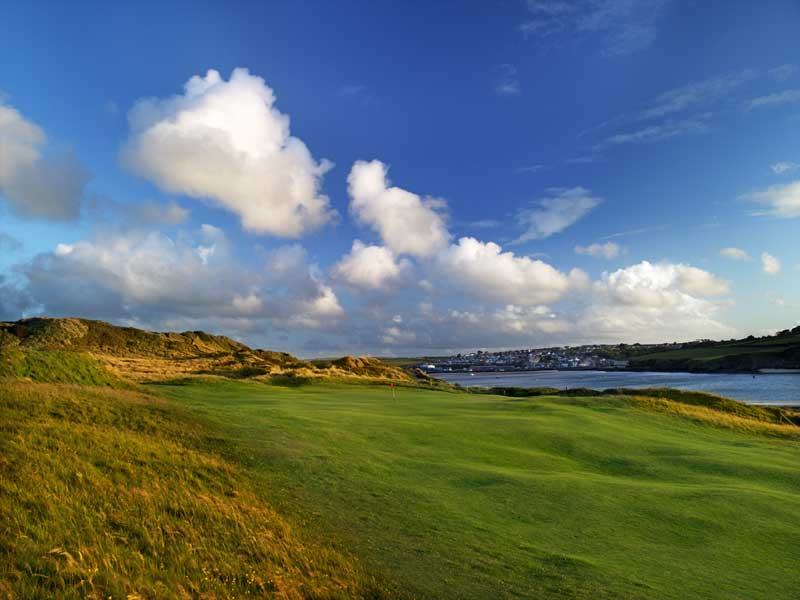
Which do you find as the toughest great course to photograph?
There is no doubt in my mind as to which course has this honor, a dubious honor as it might be. Muirfield, without a shadow of a doubt in my mind. I found it difficult to find a something to feature, or a landmark that I could use to give interest to my images.
Like many of the courses in the UK and Ireland I was plagued by poor weather. The occasional burst of sunlight helped at times, but I really struggled to find a spot to capture Muirfield. Stuart Appleby came to grief in the playoff for The Open in the narrow greenside bunker at the 18th. Sand traps don’t have to be huge deep caverns in order to cause problems. Probably my favorite picture of Muirfield is of that bunker with the clubhouse in the background.
.jpg)
I don’t consider that I was able to capture the essence of Muirfield, whatever that is. Of all the courses I visited Muirfield is the one I simply don’t get. Being puzzled as to why it is so highly regarded, I emailed a number of people whose opinions I respect and asked them to educate me as to why Muirfield is so good. No-one came up with the answer, and surprisingly a number of them admitted they couldn’t figure it out either. The course has many fans on this website, and despite their various entreaties of “tough but fair.” I have to say I am no great admirer, either golfing wise, or photography wise. But then, it is the subjectivity of opinion in regard to golf courses that makes it all so interesting. Where would GCA be if the answers were simply black and white?
How do you balance the Ëœwow’ factor with the need to capture good golf qualities?
Like most photographers I will try to take my shots from the perspective of the golfer. Generally this means roughly from the fairway, or some mounding or a hill from which I can show the passage the golfer will traverse.
I think there is a great deal of subconscious thought going on in the mind of the golfer. Things like avoiding the fairway bunker, the OOB, or the water hazard etc. Usually these elements are somewhere along the fairway and the golfers encounter them on their journey along each hole. The better the course the more of these features exist for me to use in an image. I like to be able to remind golfers of the perils they negotiated while playing a hole and if these are simple to incorporate in a photograph it is usually indicative of a quality golf course.
As well as the golfing challenges ever present in the golfers minds there is also the environment that they are absorbing. Be that pounding ocean waves, towering mountains or rolling sand dunes it makes an impression on them and I try to remind them as best I can what the surrounds were in which they played. Well ¦..not quite what they saw. I’ll go back at sunset or sunrise and capture it at its best whereas the golfers have probably seen it during the middle of the day, taken a quick photo and wondered why it didn’t look as great as what they remember.
If you have either the grand scenery, or a great golf course, there are generally plenty of options available. A great golf course in a spectacular setting is just an absolute joy.
Man-made lakes are ubiquitous and at some point they must all start to look the same. Are there any that you feel are particularly well done and that look natural when photographed?
It probably sounds almost sacrilegious on this website which exalts all things architectural, but I really don’t take too much notice of whether lakes are man-made or not. My main concern is whether or not I can use a lake effectively in a photograph.
Just to make some comment about effective man-made lakes, I think it would be fair to say that the lakes at Les Bordes have a very natural feel to them and were attractive elements within the photographs I took while there.
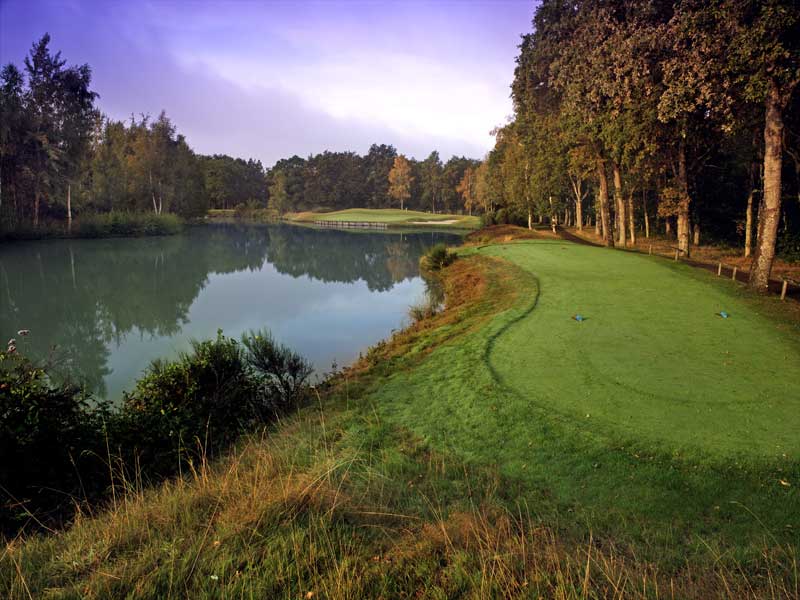
At times lakes added visual interest to a shot, the fifth and thirteenth at Hirono come immediately to mind as do a number of the images at Oviinbyrd in Canada.
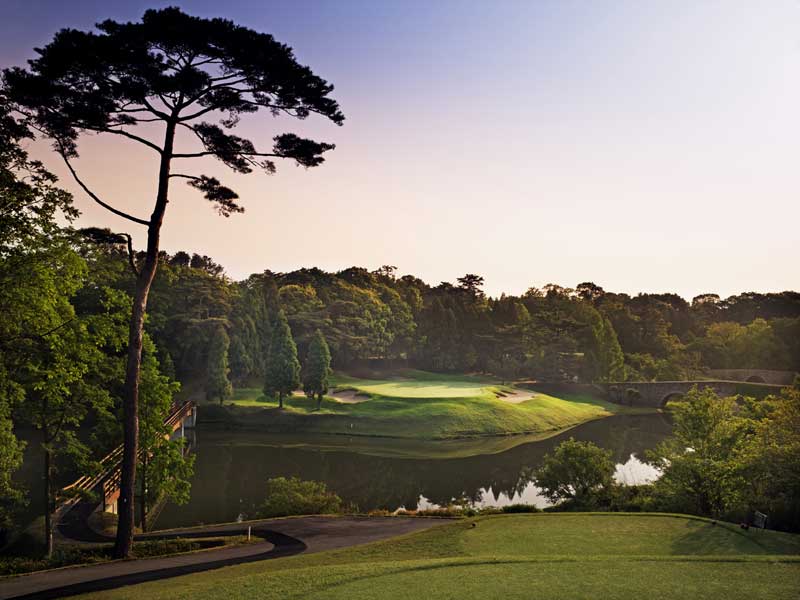
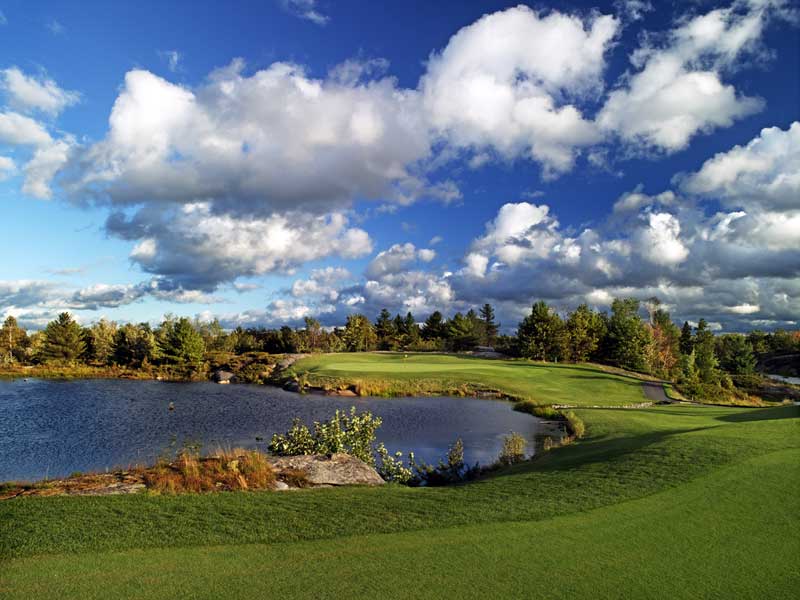
The ninth at Oviinbyrd in Canada.
Do great courses yield great photographs, as they tend to yield great champions?
Yes, I think they probably do.
The great courses tend to have elements like undulating fairways, strategic well placed bunkers, and visually interesting sites for the greens. All these golfing assets give the photographer options as to what to place in the picture. And by doing that the golfer can be reminded about what it was that inspired, confounded and interested them about the course.
And maybe it also brings back in to focus the point at which their round was wrecked by an errant stroke. Great courses tend to humble golfers at times and while it may seem a negative to induce the golfer to recall that experience, it can also stir the golfer to return, when possible, to take up the challenge once again. I try to cause the viewer to feel proud of their golf course, if they are a member, to stir a desire in non members to have the chance to play a course, or for everyone to relive past glories and disasters. If I manage to do this then I think the photograph is successful. And the great courses tend to yield these images.
In addition though are the vagaries of weather. A beautiful sunrise or dramatic sunset can make even a mundane course look spectacular. So it is not always necessary to have the chance to shoot a great course to make a great photograph, but it undoubtedly helps.
Given the growth of spectacular new courses, from South Africa to New Zealand to Australia, has the emphasis been put on trying to “one-up” other courses with a beautiful shot?
Presumably new golf courses are built to return a profit, with the exception of some private courses such as Ellerston et al. A few years ago I photographed a single hole at a lesser known golf club here in Melbourne for a local golf magazine. According to the manager of the club within a week of publication the course had received 3 or 4 new enquiries regarding membership. It seemed that people were unaware that a good golf course existed within the area.
New courses probably don’t consciously attempt to “one-up” the competition, but in an effort to make a return on the investment they need to have a beautiful image to entice and captivate the potential market.
What request has changed the most dramatically since you began shooting golf courses?
I don’t think the requests have changed much at all over the years. Clients are simply interested in showing their courses in the best possible manner for the reasons stated in the previous answer. In most instances the clients respect my opinions on what will look good, and generally leave me to my own devices. Coming from an advertising background, that is a great place to be. I no longer have an art director looking over my shoulder telling me what to do.
For amateur golf photographers, what tip can you offer?
First of all I would say to treat golf and photography as two separate tasks.
Enjoy the golf, and while playing the round take note of what positions look great. Also consider where the sun will rise and set and then return either at sunrise or sunset when the light is at its best. The morning shoots are the hardest, although if you are blessed with a grand sunrise the effort will seem worthwhile.
Good photography is about planning and being there at the right time. I don’t think it is really rocket science. A bit of forethought, a generous helping of patience, add a small dose of good luck and your images might start to show a little magic. The best compliment I can receive is when a non-golfer, who doesn’t know a driver from a wedge, tells me a particular image appeals to them.
Does the rise of spectacular oceanfront courses make the job of Planet Golf all the more difficult, as such interesting courses can open up each year?
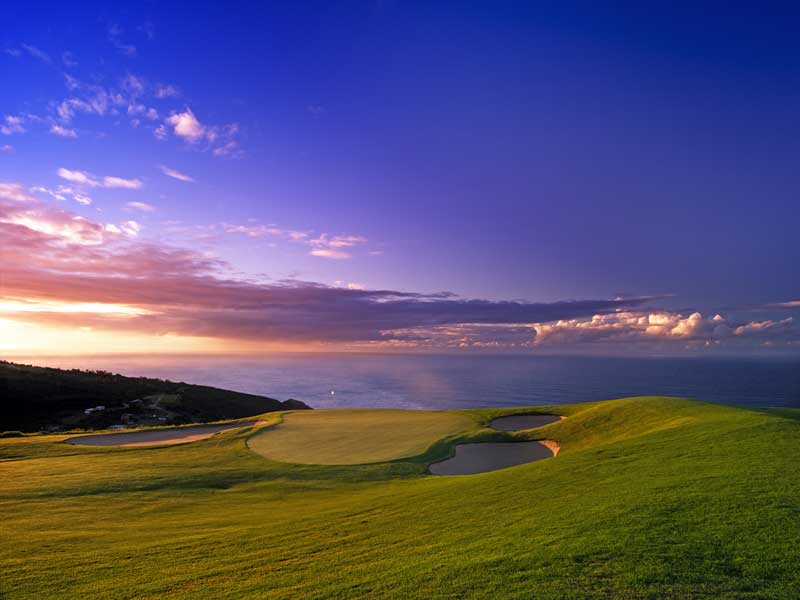
The seventeenth at Oubaai.
You can only present what exists at any given point in time. The opening of new courses just means that there are different possibilities for any future editions of Planet Golf. From a personal point of view as a photographer I can only look forward to the possibility of photographing some of these spectacular courses.
What golf courses do you think was most unaware of their quality?
Given that we were covering the finest golf courses outside the US in Planet Golf I don’t think any golf course that I visited to photograph ever considered themselves unworthy.That is not to say that they were all immodest. I think pretty much all golf clubs consider themselves to be the best undiscovered gift to golf. And that is perfectly understandable. Members of golf clubs have an almost proprietorial pride in their club and usually believe it is unjustly under-rated in the latest “Best of” list. I think that self-belief in your home club is healthy and desirable.Having said that, I recently photographed a club which has recently relocated on the outskirts of Melbourne and might potentially fall in to this category. Sunshine Golf Club is plonked very much in an industrial area of Melbourne, with views over the not too distant city skyline. It has only been opened for a short time, and is quite immature. But given time I think it may grow in to quite a good golf course. Sunshine came in to being on a much, much lesser budget, but its proximity to the industrial areas and the views across the city skyline remind me a little of what I have read and seen of Bayonne, albeit on a much smaller scale.Sunshine Golf Club.
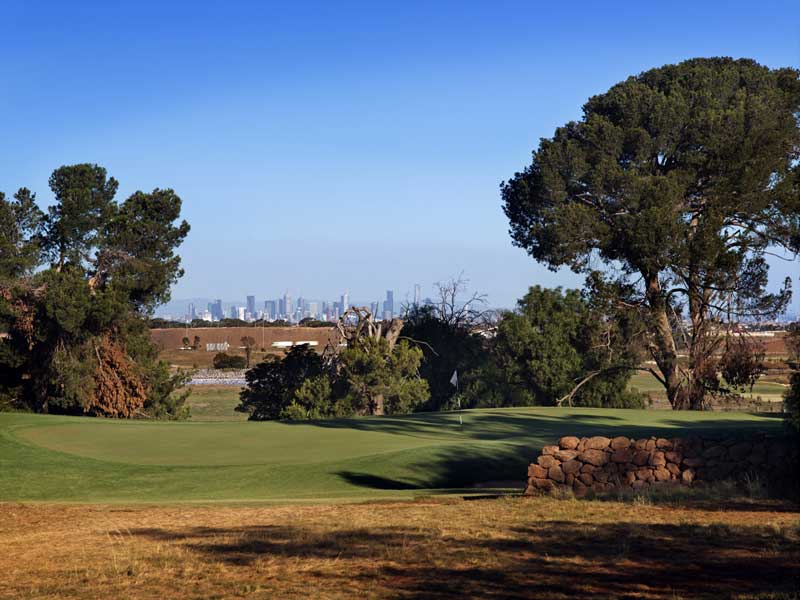
Sunshine Golf Club.
How do youcapture a low profile course like Portmarnock when more visually dramatic courses are always being built?
Like most photographers I will try to take my shots from the perspective of the golfer. Generally this means roughly from the fairway, or some mounding or a hill from which I can show the passage the golfer will traverse.
With a course like Portmarnock I feel I am even more at the mercy of the weather. When there are no dramatic visual elements provided in the topography I feel as if I need some assistance from Mother Nature.
I would look around for bunkers to place in the foreground, perhaps some golden coloured rough that can add interest in the late evening light, perhaps even the undulations in the fairways.
It’s ironic that you ask this question in regard to Portmarnock, as I found it almost as difficult to photograph as Muirfield. Both these courses were low profile and pretty dull weather-wise when I was there.
What are your favourite places for a game in Australia and why?
My favourite place to play golf in Australia, and for that matter anywhere, is my home club, Commonwealth Golf Club. Golf for me is more the sum of the parts of the experience. The game itself is just one part of it. At Commonwealth I am playing with golfing mates and enjoying the sense of community that exists in any good golf club. Virtually from the moment I am taking the clubs from the car to the time I eventually leave at the end of the day I am enveloped by the experience of playing a game I love with a bunch of great friends. The camaraderie is unequalled, and that is what I enjoy about the game of golf. (The almost continual losing of bets recently has not diminished the pleasure of being there. Surely my form has to improve soon!)
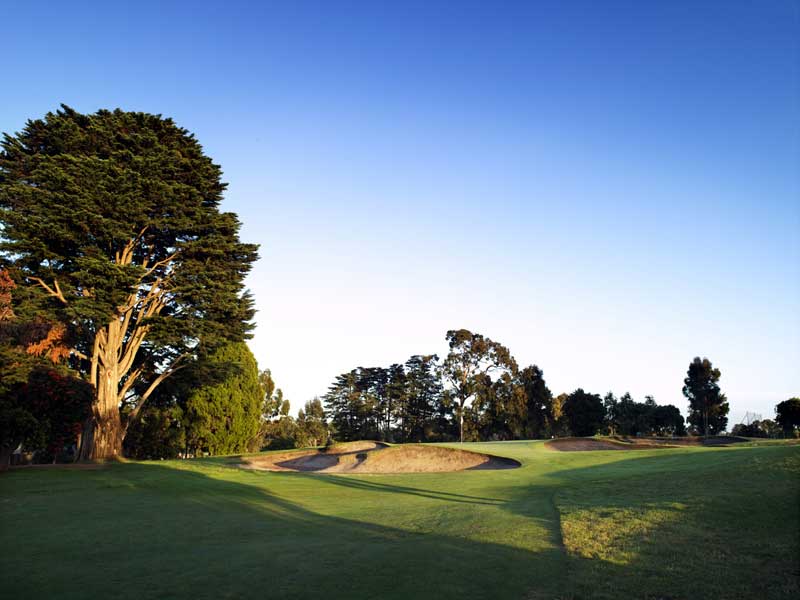
Aside from Commonwealth I look forward to playing the National Moonah. I suppose Greg Norman was one of the greatest drivers of the ball, and the tee shots at the Moonah never cease to excite. I always just want to hit the ball when I am there.
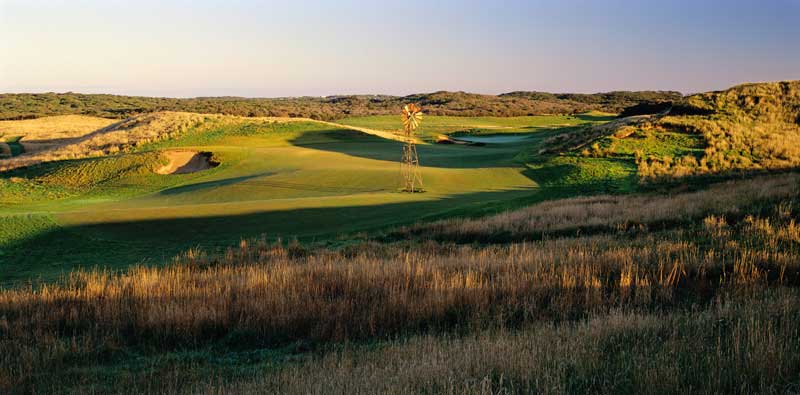
On the occasion when I manage it, a game on Royal Melbourne West is a day of fun. It is really one of the great treats of Melbourne golf. But Melbourne is truly blessed and golf at any of our esteemed courses is something to look forward to, my other favourites being Kingston Heath, Victoria, Metropolitan and Woodlands.

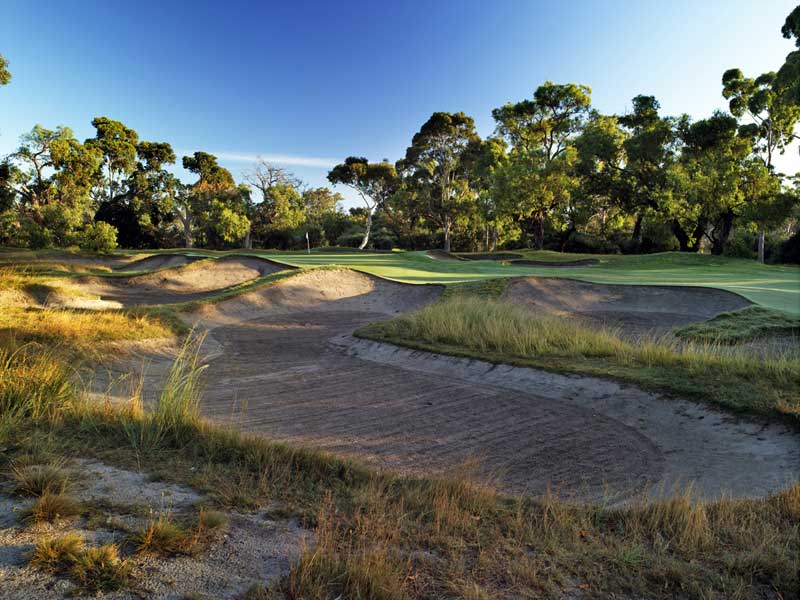
What affects have the water shortage had on Australian golf and your business?
Initially this had a large effect on my work. I put it down to clubs simply not wanting to show their courses with brown fairways, which naturally is understandable. However, over the last year or two I think the population in general, as well as the golf clubs, has become much smarter in the utilisation of our water resources and despite the lack of rain a more efficient use of the water resources we have has our courses looking much better.
Planet Golf had me away from Australia for more than two years, and when I had finished photography for the book I started looking for work again at the time of drought. Given that I had been away for so long I suspect that golf clubs may have thought Scaletti was no longer photographing golf courses. It has taken some time to rectify that situation and work is now increasing favourably.
Does being Australian make your job as an international photographer harder or easier?
Probably harder I would suggest. There may be some sense of novelty in having an Australian photograph a course in the US for example. However there is the added cost of travel versus the convenience of local photographers to carry out the work. Conversely, the same situation protects the Australian photographers. The only problem with that from my point of view is that the Australian golf market is small, and the number of opportunities is limited.
Planet Golf will showcase my work on an international level, and I am very much looking forward to discovering if this will open up assignments in other parts of the world.
How were you received in Japan and what did you think of the golf?
Japan was fantastic. I was incredibly apprehensive about Asia and travelling there by myself. After years of doing that throughout the rest of the world you might wonder why that would be, but I was simply afraid of not being able to read signs or communicate when I couldn’t understand where I was supposed to be going. Thanks to Masa Nishajima and his efforts in organising my trip I was pretty much wrapped up in cotton wool and given a guided tour around Japan. I have nothing but fond memories of Japan and hope to return there.

My travels took me to Tokyo, Kasumagaseki, Kawana, Naruo, Hirono and Koga golf clubs. Although I didn’t have the chance to play it, Hirono was the stand out course. Kawana was tremendous fun, and I did play it a couple of times. I also journeyed around Naruo and Koga with golf clubs in hand, and found them to be challenging and enjoyable courses to play.
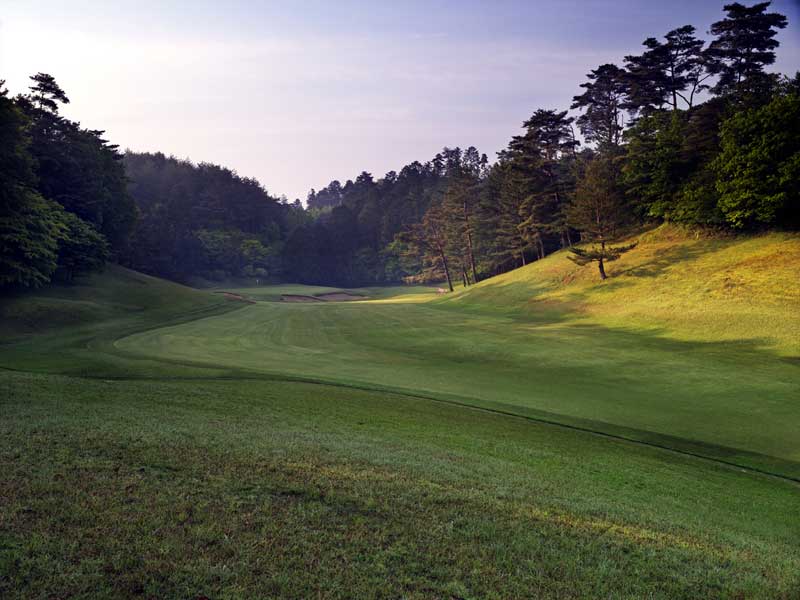
My apologies for not giving an architectural synopsis of the courses, but I don’t feel qualified to say much in that area with any great authority. Suffice to say, the time at each club was one to be savoured and remembered and, hopefully, to be experienced again in the future.
Finally, which is your favourite photograph?
Choosing a favourite photograph is a little like asking which is my favourite child. My answer would vary and I probably would make a list of preferred images which probably spring immediately to mind. However I think any list I might conjure up would definitely include three pictures. Banff 4, Ballybunion 15, and Teeth of the Dog 16.Banff 4 appears earlier in the interview and it makes my list not only because Banff was a place where I spent a very enjoyable twelve months of my life, but the spectacular nature of the hole with Mt Rundle rising up dramatically and majestically behind the green just inspires me and gets me dreaming about going off playing golf, or working, in a beautiful location somewhere in the world.
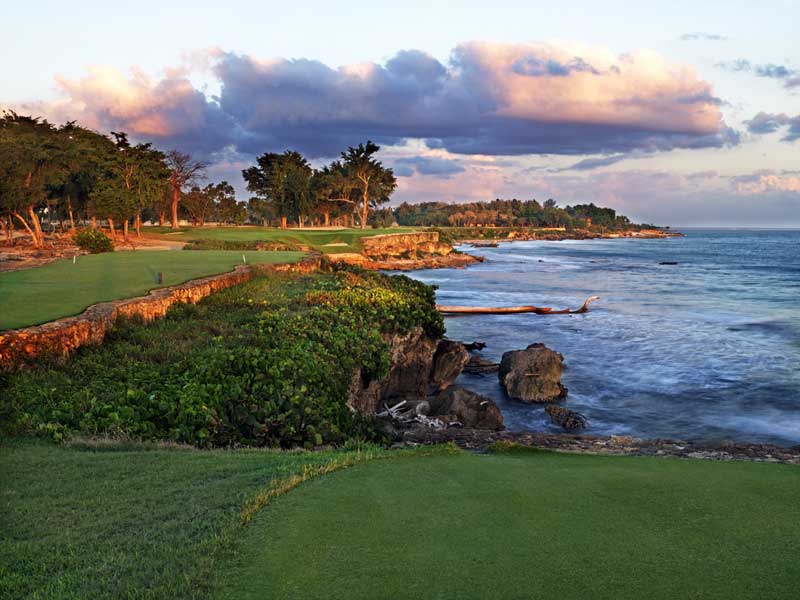
Teeth of the Dog 16th is such a relaxing image. Gentle breezes, a beautiful sunset, golf doesn’t get much better than this. I have this photograph above my desk at home.
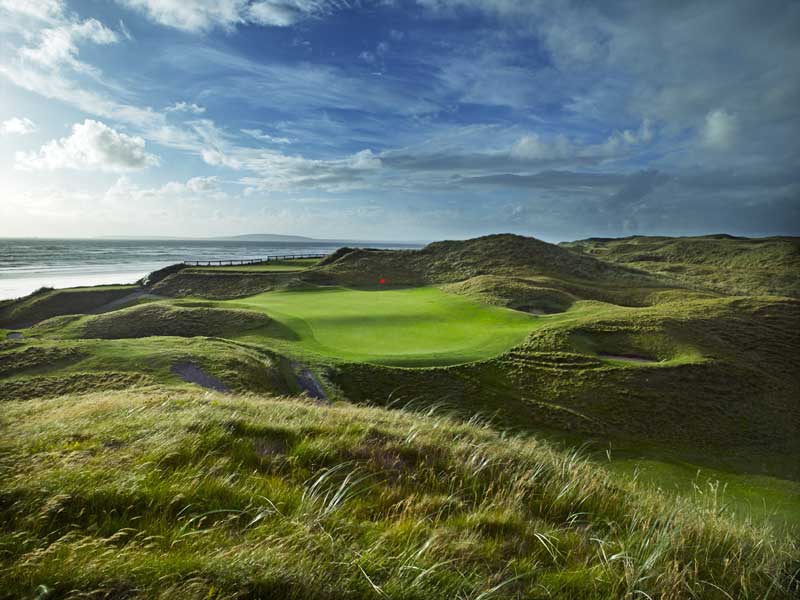
And finally, Ballybunion 15. I don’t remember having any great success in a golfing sense, but I always found it to be a hole I approached with great anticipation, despite average results. Photographically I just thought it had all the elements I wanted, heaving dunes, and contrasting colours between the fairway, green and rough. But, just to complete the picture, the fabulous swirling clouds present on that particular day make an image that I am really pleased to have captured. The ever-changing weather of South West Ireland closed in immediately after the shot was taken and I had to make a quick exit back to the clubhouse.
One of the exciting aspects of my job is that possibly this afternoon, maybe tomorrow morning, or perhaps next month I just might get the very best golf course photo I have ever taken.
The End
-
Ran Morrissett is the Co-Founder and President of Golf Club Atlas.
View all posts










.jpg)



















